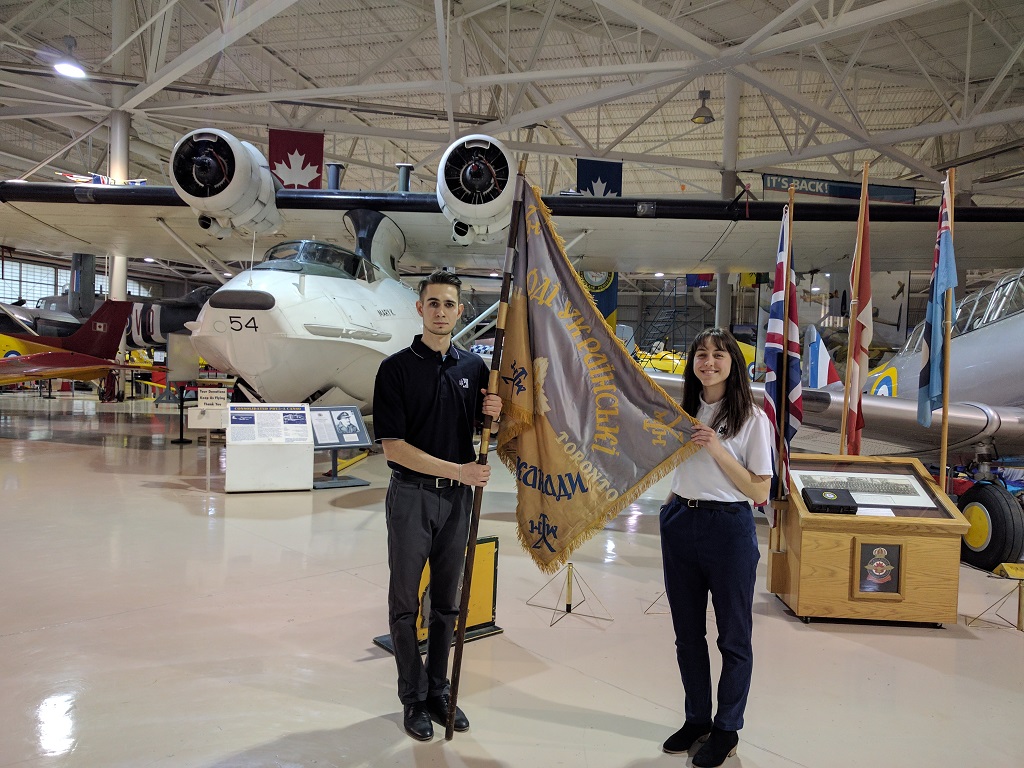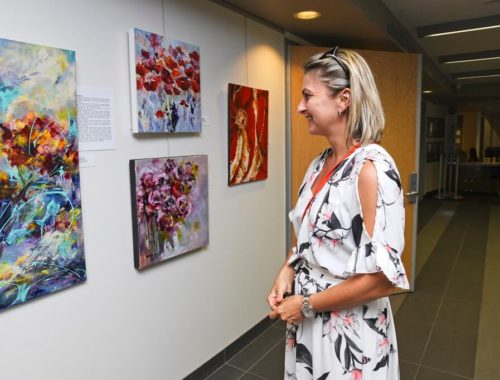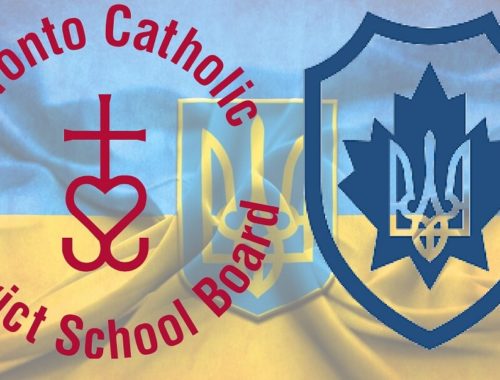
Night at the museum – MYHO takes flight once again
Ukrainian youth in Toronto lived through a real-life plot of the infamous “Night at the Museum” saga.
The Canadian Warplane Heritage Museum in Hamilton, ON., invited five members of the Ukrainian National Youth Federation (MYHO) Toronto branch and five members of the UNF Camp Sokil to spend the night among the planes last Saturday. Museum’s program “Nite Ops” is limited to groups such as cadets, scouts and guides, but the Museum made an exception for MYHO upon learning about the extraordinary contribution of MYHO’s early members to Canada’s Second World War effort.
“MYHO anticipated that something big was going to happen and they prepared for it by starting this flight school,” said MYHO’s president Yura Dunets during the trip. “They took initiative, and they were ready to fight for their identity on foreign lands. That’s a very important thing to teach the kids – you step up for what’s right. MYHO boys in 1930s saw that something was wrong, they were not afraid to stand up.”
In 1938 members of the MYHO Oshawa branch established a flight school, which trained young Ukrainian men to become pilots, captains, navigators and paratroopers. These men later joined the Royal Canadian Air Force (RCAF) and fought in the Second World War.
The Museum’s “Nite Ops” program teaches youth about the RCAF contributions to the war effort. After an educational part, older children stay the night at the Museum and sleep under the warplanes. The downside – only cadets, guides, scouts and similar groups are allowed to participate in the program.
That changed when Anastasia Baczynsky, youth programming director at the Ukrainian National Federation of Canada (UNF), wrote a letter to the Museum about MYHO’s contributions to the RCAF. She promptly received permission for MYHO and Sokil to join the program.
Dunest said that past MYHO members gave their lives for Canada and present MYHO members raised their flag in their honour at the Museum’s colours ceremony. It was the first time that a non-cadet, non-guide, non-scout group raised their flag on the Museum’s grounds – and for MYHO it was an emotional moment of pride.
“Serving the Canadian Forces was an honour that Canadian Ukrainians brought to the table; it needs to be recognized as part of our identity too,” Dunest said. “Now we are training our future leaders and the fact that past MYHO members served in RCAF will show them the importance of taking leadership.”

Baczynsky learned about the flight school by accident, from a picture hanging at the UNF building in Etobicoke, ON. On it, Canada’s Senator Paul Yuzyk stands with three men by a plane with MYHO emblem on its tail.
UNF Oshawa’s long-standing Treasurer Dan Cherkas immensely helped Baczynsky with the research by lending her the flight school’s archive, which belonged to the flight school’s principal and instructor Mike Wladyka. The album, compiled on Manila paper, contained articles, personal photographs, ribbons, flight training punch cards, raffle tickets and other artifacts.
As Baczynsky learned, in 1937, MYHO made a proposal to the UNF National Executive to start a flight school. The school was supposed to prepare pilots and paratroopers for the Canadian Armed Forces and at the same time keep the Ukrainian community together. By serving Canada this way, MYHO felt that they would serve Ukraine in some measure too. The National Executive agreed and delegated the responsibility to UNF Oshawa.
Then MYHO in Oshawa began raising funds for a training plane, which cost $1,325 (more than $18,000 in today’s money). They sold tickets to and staged a play titled “Navala”, collected donations from the community and raffled a car which was donated by General Motors, with 10,000 tickets (worth $1 each). The money was to be spent on the plane, gas, training and other necessities. In total, they raised $500. The school was organized as a private club thus all MYHO members that joined paid membership fees, covering the rest of the expenses. The money was spent on a brand new Canadian-made Auster observation-training plane, which they named Yevhen, in honour of Yevhen Konovalets.
The official opening of the school was held on 13 February 1938 at the UNF Oshawa hall. Attending mayor of Oshawa Alex McLeese was made the School’s honorary member. Remarkably, the push from the Ukrainian community and the needs of the MYHO flight school led to the creation of a small municipal airport in Oshawa, which exists to this day.
When the Second World War broke out, MYHO members at the flight school were ready to join the fight. They joined the RCAF as trained pilots, flight captains, navigators, and paratroopers. Many of them never made it back home.
Flight Sergeant Navigator Eugene Salmers was one of them. An article from the New Pathway archives dating June 1942 describes how tragic his death was to MYHO, his community, the choir where he sang, and most of all to his mother, who could not accept her son’s death and required constant doctor’s supervision. The Canadian Warplane Heritage Museum lists his name in its book of commemoration.

Once MYHO members joined the war and the school closed down, debates arose about Yevhen’s destiny. Eventually, the RCAF repurposed it as its own training plane. Yevhen’s further fate remains unknown, but Mike Wladyka’s archive has a picture of Yevhen’s full registration number: CF-BGV, which remains in Toronto’s Ministry of Transportation archives. Baczynsky plans to track the number and find out Yevhen’s final fate.
“It would be nice to have some kind of closure,” she told the New Pathway. “This is a very important part of MYHO’s history. MYHO gave a lot to the war effort – they served faithfully and they died. And MYHO should be very proud of that and should be aware of this part of their identity.”
Baczynsky digitized Mike Wladyka’s archive to preserve the memory of the school. The fate of the physical copy is being discussed, and there is interest on the part of the Canadian Warplane Heritage Museum to look at the archive and perhaps put it on display.
Coincidentally, MYHO’s trip to the Museum on Saturday was around the anniversary of the first Aviation day in Oshawa organized by MYHO back in 1938. It was also the first trial trip for Baczynsky’s new youth program at UNF. The point of the program is to make the Ukrainian Canadian youth aware that Ukrainians served Canada loyally, and that this is part of who they are.
“MYHO kids should feel pride in the organization’s contribution to Canada, and feel the pride of belonging to the organization,” she said during the trip. “Because of that service they are leaders and the program is meant to build leaders.”
At the Museum, both MYHO and Sokil members learned about the contributions of Ukrainians to the Canadian war effort from the President of the Ukrainian War Veterans Association of Canada Cpt. Andre Sochaniwsky, explored the physics of a flight and toured the Museum’s restricted grounds under staff’s supervision.
After visiting the Museum, MYHO’s president Yura Dunets said he believes that trips like this will help better shape the identity of young Ukrainian Canadians.
“Being in the Museum so close to the planes, realizing how much damage those planes could bring and experiencing what the pilots might have experienced will definitely leave an impression on these kids and help form their identity as proud Ukrainian Canadians,” he said.
Baczynsky wants MYHO members to be proud of who they are.
“MYHO members went to war because they had to serve their country – Canada – as they knew that they were a part of a bigger community than just the Ukrainian one. And it is important to realize this for young kids too – they are part of a bigger hromada, community, a nation.”
“We are Ukrainian Canadians – we step up when something is wrong. These boys stepped up for what was right. We are not much different,” she said.
Kateryna Bandura for New Pathway – Ukrainian News
Follow me on social media!You May Also Like

Power of Six art exhibit captures hearts at Halton Hills
September 17, 2019
The Shevchenko Foundation launched new mentorship program
January 2, 2019

